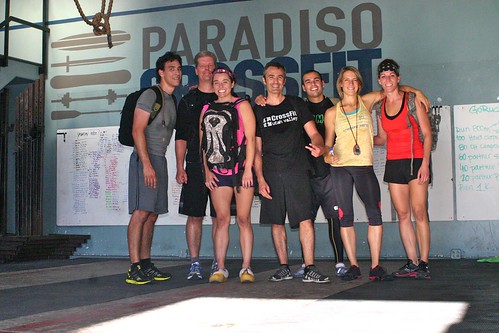Know Thyself
Monday, October 29, 2012
Sign up for the Beach Cruiser Triathalon this Sunday! More details this Wednesday!
Click HERE for the Weekly Programming! HERE for On Ramp!
Warmup/Mobility:
Jog 400 meters
10 Good Mornings with Barbell
10 GHD Situps
10 Back Extenstions
Practice Bar Taps
Notes: For the Bar Taps, focus on perfect form! This means no bending of your arms in the front or back of the swing. Stay tight as you move from hollow into the arch position. Focus on the use of your lats. Keep your feet together and use a bar height that allows your feet to swing freely.
Barbell Gymnastics:
5X3 Snatch Grip Deadlift (stopping at the top of the knee) – heavier than 1RM Snatch (110% +)
Notes: This should feel exactly like the first pull of the snatch. Drive the knees back, feel the tension in the posterior chain, and bring the shoulders over the bar. This may be painful on the hook grip, so feel free to bring straps if you’ve got em!
Conditioning:
30 Toes to Bar
20 Thrusters 115/75#
Run 800m
20 Thrusters 115/75#
30 Toes to Bar
Notes: If you cannot perform toes to bar, substitute GHD situps, V-ups or Knees to Elbows.
Cool Down:
10 Wall Extensions
Straddle Stretch, 1 minute
Quad on Wall, 1 minute each
Pike Stretch, 1 minute
10 Wall Extensions
Please comment below or email us if you would like an invitation to join us on Beyond the Whiteboard FOR FREE! Continue reading if you want to know why this is so important…
A large part of our Outlaw Training Camp last week was the approach to CrossFit as a sport. While we have not designed our gym around the development of elite CrossFit athletes the concepts still relate to anyone wanting to optimize their returns in the gym.
Know your Numbers so you can use the percentages! The weight percentages and rest schemes that we use in our strength/skill portion of the workouts are based upon Prilepin’s Chart, they are not randomly chosen! This can be challenging for the Olympic Lifts, because novice athletes may still be working on their technique and building up to a true 1RM. For instance, there is a possibility that a strong athlete might have a really low snatch weight because of technique/mobility issues, causing their percentages to feel ‘too light.’ This is ok in the short term and a strong reminder to work on their limitations! This will make the increase in numbers even more satisfying over time. Everyone should be using the percentages for the squats though! If you do not know your current 1RM, you should take the time to determine that number because it is used so often. In the meantime, you should have some idea of this number and calculate your day’s work off of those numbers. You may make a mistake and go too high or too low, but since you are writing this stuff down, you will know better for next time. Don’t just add random weight to the bar! Know your numbers and use the percentages to optimize your strength gains!
Create a Gameplan! If you take your times and scores seriously, you should be going into every workout with a gameplan. How long will each round take you? When will you take breaks? Can you guess how long the workout will take you without seeing anyone elses time? This knowledge only comes with time and practice! Lets take a look at a workout like Nancy from last week: 5 rounds of 400 meter run and 15 overhead squats. We want to complete all of this work as fast as possible, ie winning the first 400 meters is not the goal! We need to optimize our run pace so that we can optimize our overhead squats. We need to know ourselves and test our limits. While you may be able to run a 400 meter relatively easy at 1:30, what can you maintain after the squats? Is it worth it to run that fast for your first round if you are slowed down to a 2:30 pace for the later rounds? A 2:00 pace might feel like a silly slow pace for your first round, but if you can maintain that through all rounds, you will finish the work quicker overall! How about the squats? Are you better at picking the bar up right away once you walk in from the run or should you rest 10 seconds and catch your breath so you can stabilize and move more efficiently? Should you squat snatch the first rep or should you power snatch and set yourself up with the best possible stance? We can probably all agree that not dropping the barbell is optimal, but what if you cannot perform all 15 reps in a row? What is the best plan of action. How will you change strategies from round 1 to round 5? The ability to answer these questions is a learned skill and takes time. When you first attempt to do this, you will be wrong a lot. That feeling when you are in the middle of a workout and realize that you had it all wrong is not fun, but its a learning experience! On the flip side, learning to have restraint in workouts, focusing on your strengths and strategizing your weaknesses to optimize your performance is empowering! The athletes that are successful at this skill make it look easy. Give it a try today! Think about each portion of the workout. How you want to break up the movements, what your run pace will be, and what your total time will be! Good luck and let us know how it goes!
Now hit us up to join Beyond the Whiteboard!!
















